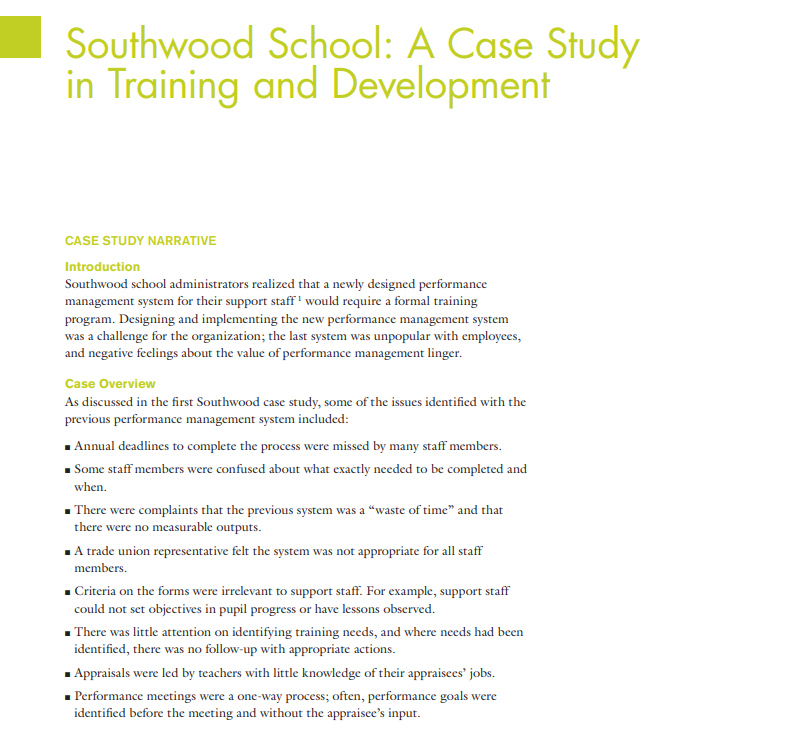
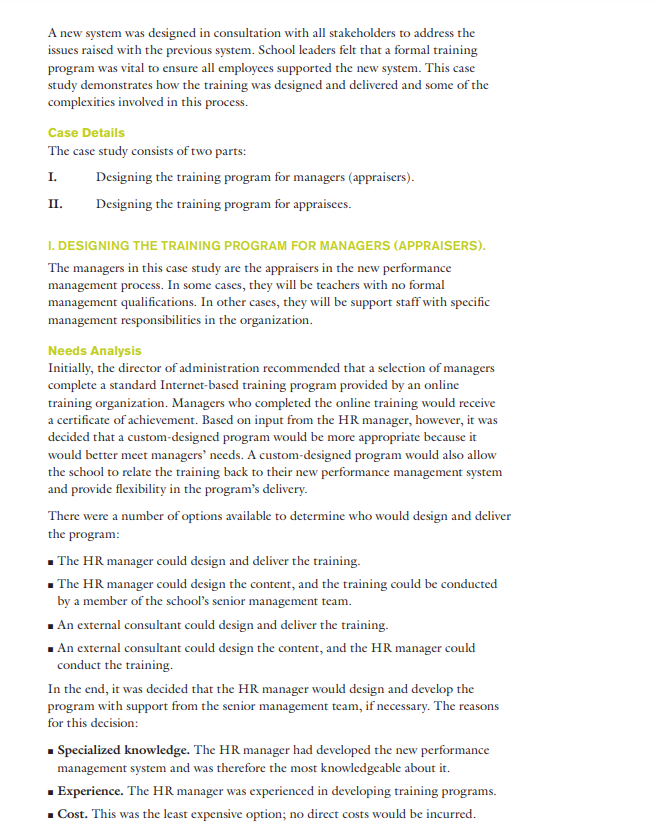
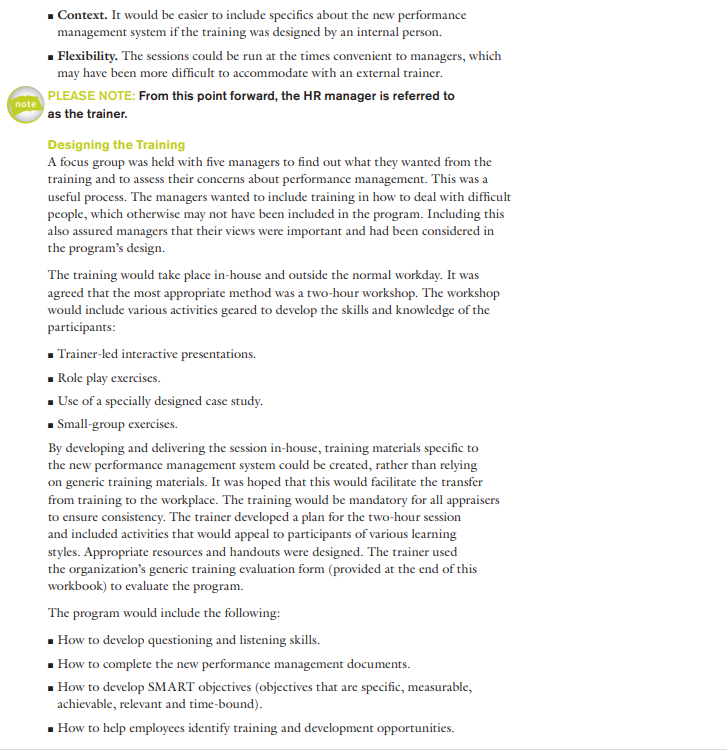

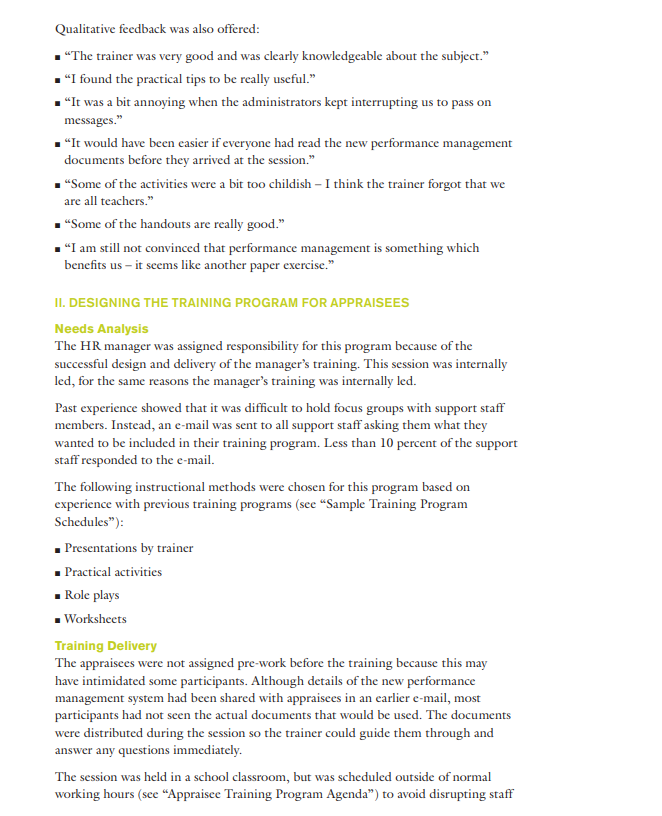

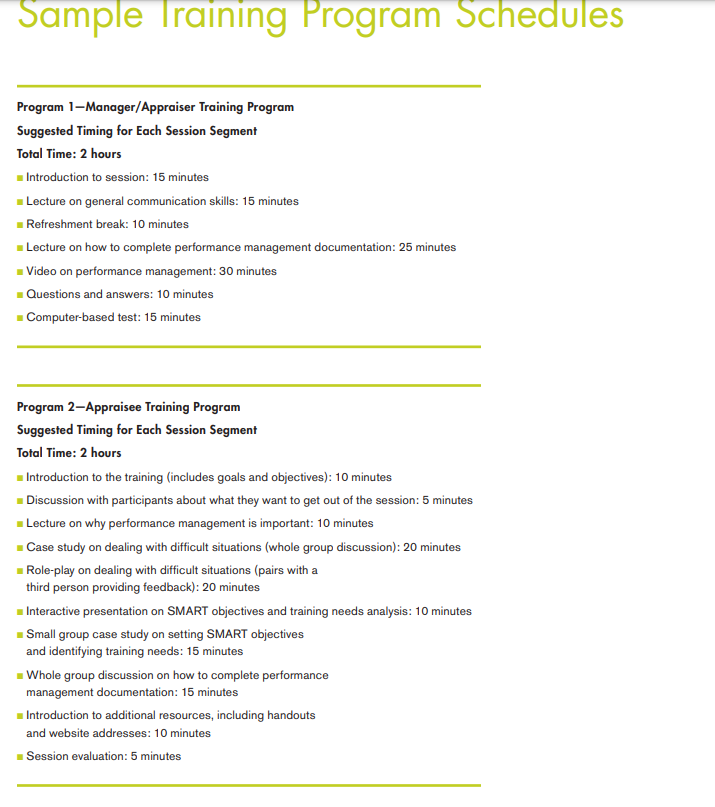
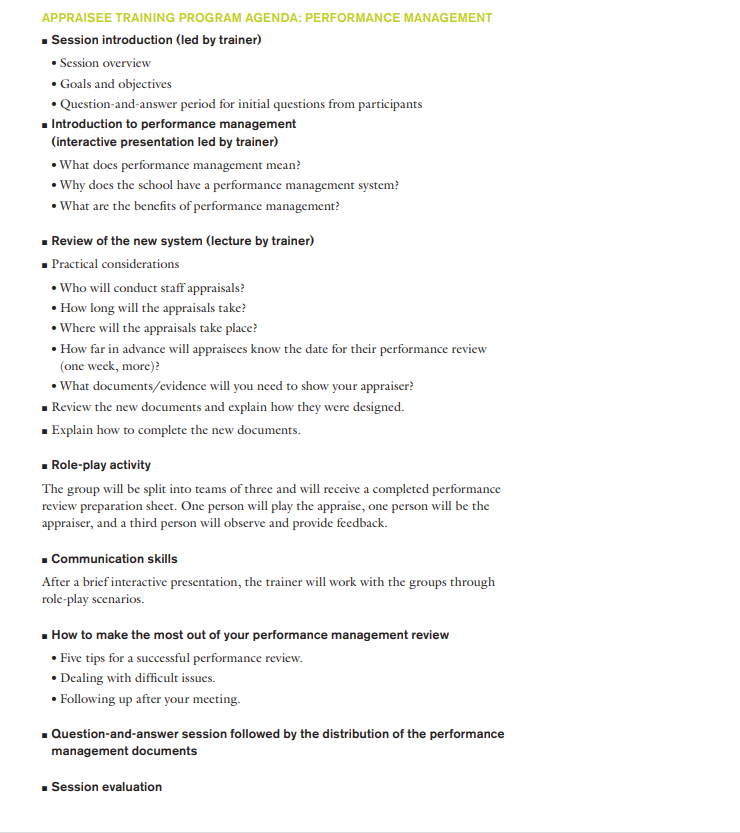

Southwood School: A in Training and Development CASE STUDY NARRATIVE Introduction Southwood school administrators realized that a newly designed performance management system for their support staff 1 would require a formal training program. Designing and implementing the new performance management system was a challenge for the organization; the last system was unpopular with employees, and negative feelings about the value of performance management linger. Case Overview As discussed in the first Southwood case study, some of the issues identified with the previous performance management system included: - Annual deadlines to complete the process were missed by many staff members. - Some staff members were confused about what exactly needed to be completed and when. - There were complaints that the previous system was a "waste of time" and that there were no measurable outputs. - A trade union representative felt the system was not appropriate for all staff members. - Criteria on the forms were irrelevant to support staff. For example, support staff could not set objectives in pupil progress or have lessons observed. - There was little attention on identifying training needs, and where needs had been identified, there was no follow-up with appropriate actions. - Appraisals were led by teachers with little knowledge of their appraisees' jobs. - Performance meetings were a one-way process; often, performance goals were identified before the meeting and without the appraisee's input. A new system was designed in consultation with all stakeholders to address the issues raised with the previous system. School leaders felt that a formal training program was vital to ensure all employees supported the new system. This case study demonstrates how the training was designed and delivered and some of the complexities involved in this process. Case Details The case study consists of two parts: I. Designing the training program for managers (appraisers). II. Designing the training program for appraisees. I. DESIGNING THE TRAINING PROGRAM FOR MANAGERS (APPRAISERS). The managers in this case study are the appraisers in the new performance management process. In some cases, they will be teachers with no formal management qualifications. In other cases, they will be support staff with specific management responsibilities in the organization. Needs Analysis Initially, the director of administration recommended that a selection of managers complete a standard Internet-based training program provided by an online training organization. Managers who completed the online training would receive a certificate of achievement. Based on input from the HR manager, however, it was decided that a custom-designed program would be more appropriate because it would better meet managers' needs. A custom-designed program would also allow the school to relate the training back to their new performance management system and provide flexibility in the program's delivery. There were a number of options available to determine who would design and deliver the program: - The HR manager could design and deliver the training. - The HR manager could design the content, and the training could be conducted by a member of the school's senior management team. - An external consultant could design and deliver the training. - An external consultant could design the content, and the HR manager could conduct the training. In the end, it was decided that the HR manager would design and develop the program with support from the senior management team, if necessary. The reasons for this decision: - Specialized knowledge. The HR manager had developed the new performance management system and was therefore the most knowledgeable about it. - Experience. The HR manager was experienced in developing training programs. - Cost. This was the least expensive option; no direct costs would be incurred. - Context. It would be easier to include specifics about the new performance management system if the training was designed by an internal person. - Flexibility. The sessions could be run at the times convenient to managers, which may have been more difficult to accommodate with an external trainer. PLEASE NOTE: From this point forward, the HR manager is referred to as the trainer. Designing the Training A focus group was held with five managers to find out what they wanted from the training and to assess their concerns about performance management. This was a useful process. The managers wanted to include training in how to deal with difficult people, which otherwise may not have been included in the program. Including this also assured managers that their views were important and had been considered in the program's design. The training would take place in-house and outside the normal workday. It was agreed that the most appropriate method was a two-hour workshop. The workshop would include various activities geared to develop the skills and knowledge of the participants: - Trainer-led interactive presentations. - Role play exercises. - Use of a specially designed case study. - Small-group exercises. By developing and delivering the session in-house, training materials specific to the new performance management system could be created, rather than relying on generic training materials. It was hoped that this would facilitate the transfer from training to the workplace. The training would be mandatory for all appraisers to ensure consistency. The trainer developed a plan for the two-hour session and included activities that would appeal to participants of various learning styles. Appropriate resources and handouts were designed. The trainer used the organization's generic training evaluation form (provided at the end of this workbook) to evaluate the program. The program would include the following: - How to develop questioning and listening skills. - How to complete the new performance management documents. - How to develop SMART objectives (objectives that are specific, measurable, achievable, relevant and time-bound). - How to help employees identify training and development opportunities. Training Delivery Participants were asked to read all the documents related to the new performance management system before the training. The session was held in a classroom with the necessary IT equipment during non-school hours. Eighty percent of appraisers attended this scheduled session; the remaining 20 percent participated in another presentation four weeks later. Evaluation of the Training Program: The Trainer's Perspective The following is an excerpt from the trainer's evaluation report: Overall, I thought the session went really well. I covered all of the materials and had some good responses. I think most of the participants now have a good understanding of how to carry out a performance review, but I am not entirely sure they believe there are benefits to a performance appraisal system. I was a bit disappointed with two participants who did not actively participate in the activities. Perhaps they thought they already knew the information. I might have misjudged one of the communication activities. I estimated that it would take about 45 minutes, but everyone completed it in 20 minutes. Unfortunately I didn't have any extra activities, so I had to stretch out the final discussion so we didn't finish too early. Evaluation of the Training Program: The Managers' Perspective Managers were asked to provide feedback at the end of the training. Some of the results are shown below: Qualitative feedback was also offered: - "The trainer was very good and was clearly knowledgeable about the subject." - "I found the practical tips to be really useful." - "It was a bit annoying when the administrators kept interrupting us to pass on messages." - "It would have been easier if everyone had read the new performance management documents before they arrived at the session." - "Some of the activities were a bit too childish - I think the trainer forgot that we are all teachers." - "Some of the handouts are really good." - "I am still not convinced that performance management is something which benefits us - it seems like another paper exercise." II. DESIGNING THE TRAINING PROGRAM FOR APPRAISEES Needs Analysis The HR manager was assigned responsibility for this program because of the successful design and delivery of the manager's training. This session was internally led, for the same reasons the manager's training was internally led. Past experience showed that it was difficult to hold focus groups with support staff members. Instead, an e-mail was sent to all support staff asking them what they wanted to be included in their training program. Less than 10 percent of the support staff responded to the e-mail. The following instructional methods were chosen for this program based on experience with previous training programs (see "Sample Training Program Schedules"): - Presentations by trainer - Practical activities - Role plays - Worksheets Training Delivery The appraisees were not assigned pre-work before the training because this may have intimidated some participants. Although details of the new performance management system had been shared with appraisees in an earlier e-mail, most participants had not seen the actual documents that would be used. The documents were distributed during the session so the trainer could guide them through and answer any questions immediately. The session was held in a school classroom, but was scheduled outside of normal working hours (see "Appraisee Training Program Agenda") to avoid disrupting staff Training Program Evaluation The trainer ran out of time during training. Consequently, no formal evaluations were submitted by participants. The trainer thought it had been a challenging session; it had been difficult to engage the participants. The participants had very different needs and it was difficult to accommodate them within a two-hour session. The trainer also reported that few trainees participated in the activities or asked any questions. Conclusions This case study shows that there are many issues to consider when planning, designing and delivering training programs. It is also clear that because people have different needs and learning styles, it is difficult to produce a program that will be rated well by everyone. In this instance, it was harder to satisfy people because of the topic; negative experiences with the school's previous performance management system made this training unpopular. Program 1-Manager/Appraiser Training Program Suggested Timing for Each Session Segment Total Time: 2 hours Introduction to session: 15 minutes Lecture on general communication skills: 15 minutes Refreshment break: 10 minutes Lecture on how to complete performance management documentation: 25 minutes Video on performance management: 30 minutes Questions and answers: 10 minutes Computer-based test: 15 minutes Program 2-Appraisee Training Program Suggested Timing for Each Session Segment Total Time: 2 hours Introduction to the training (includes goals and objectives): 10 minutes Discussion with participants about what they want to get out of the session: 5 minutes Lecture on why performance management is important: 10 minutes Case study on dealing with difficult situations (whole group discussion): 20 minutes Role-play on dealing with difficult situations (pairs with a third person providing feedback): 20 minutes Interactive presentation on SMART objectives and training needs analysis: 10 minutes Small group case study on setting SMART objectives and identifying training needs: 15 minutes Whole group discussion on how to complete performance management documentation: 15 minutes Introduction to additional resources, including handouts and website addresses: 10 minutes Session evaluation: 5 minutes APPRAISEE TRAINING PROGRAM AGENDA: PERFORMANCE MANAGEMENT - Session introduction (led by trainer) - Session overview - Goals and objectives - Question-and-answer period for initial questions from participants - Introduction to performance management (interactive presentation led by trainer) -What does performance management mean? -Why does the school have a performance management system? - What are the benefits of performance management? - Review of the new system (lecture by trainer) - Practical considerations - Who will conduct staff appraisals? - How long will the appraisals take? - Where will the appraisals take place? - How far in advance will appraisees know the date for their performance review (one week, more)? -What documents/evidence will you need to show your appraiser? - Review the new documents and explain how they were designed. - Explain how to complete the new documents. - Role-play activity The group will be split into teams of three and will receive a completed performance review preparation sheet. One person will play the appraise, one person will be the appraiser, and a third person will observe and provide feedback. - Communication skills After a brief interactive presentation, the trainer will work with the groups through role-play scenarios. - How to make the most out of your performance management review - Five tips for a successful performance review. - Dealing with difficult issues. - Following up after your meeting. - Question-and-answer session followed by the distribution of the performance management documents - Session evaluation 1. The HR manager/trainer elected to design two different training programs: one for managers, and one for appraisees. Discuss the strengths and weaknesses of the managers' program. What are some strategies you might utilize to overcome the weaknesses you identified? 2. Now, discuss the strengths and weaknesses of the appraisees' program. What are some strategies you might utilize to overcome the weaknesses you identified















